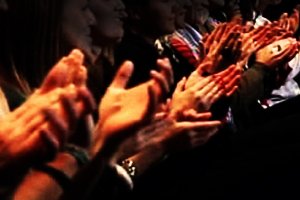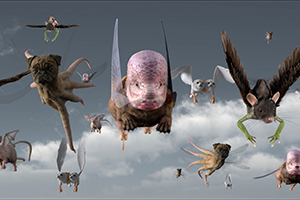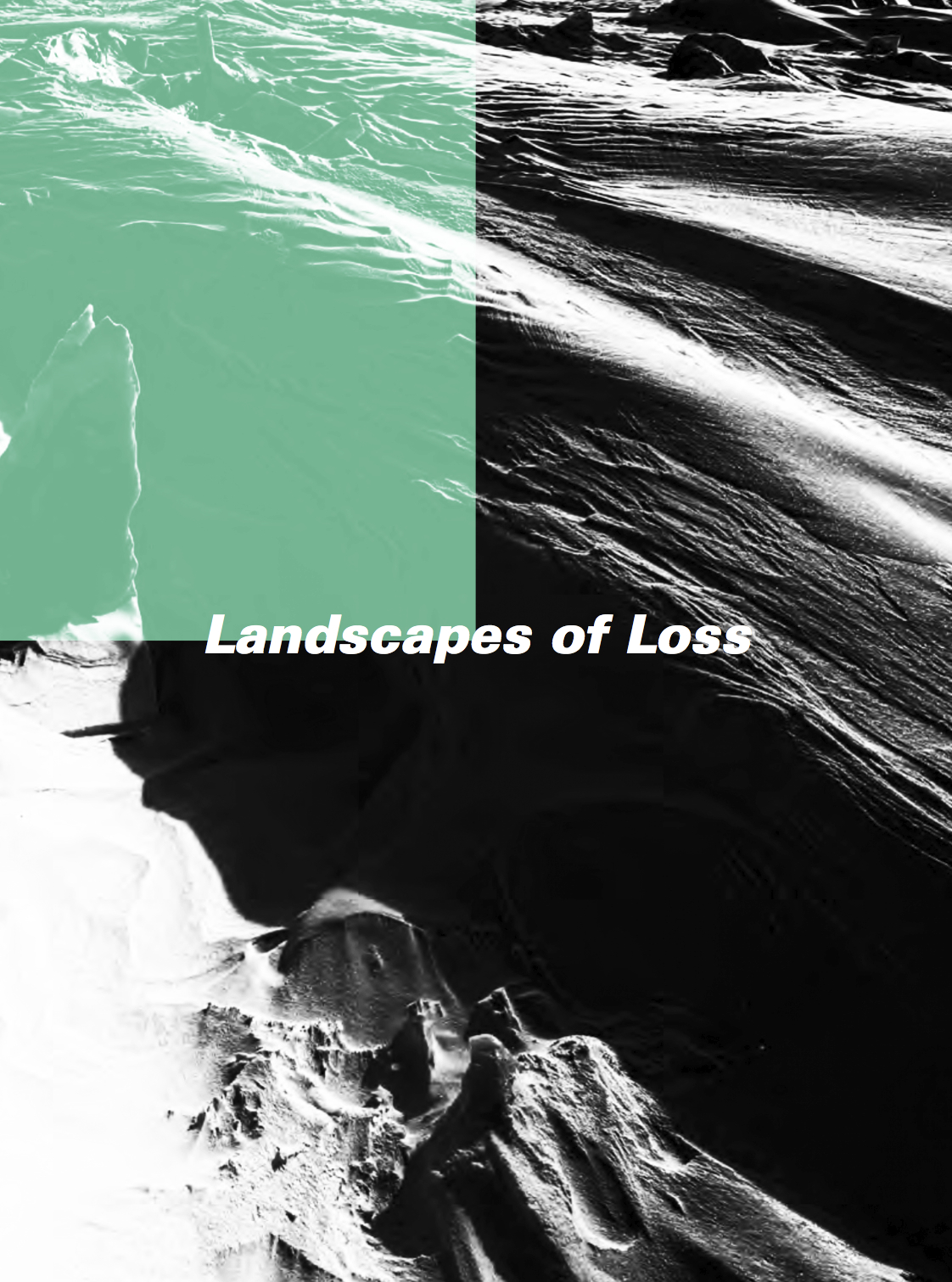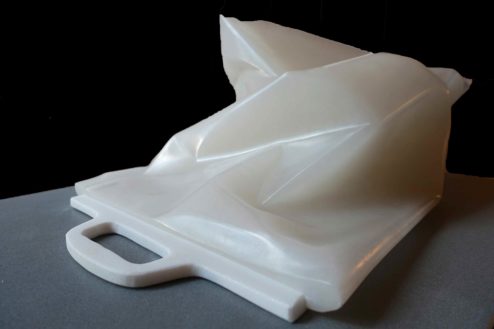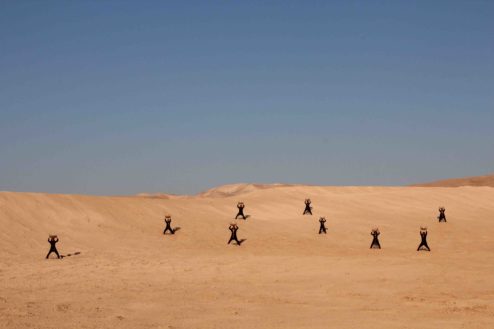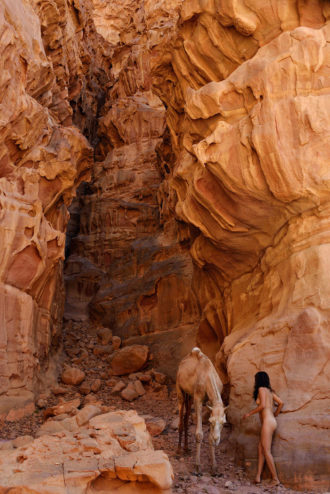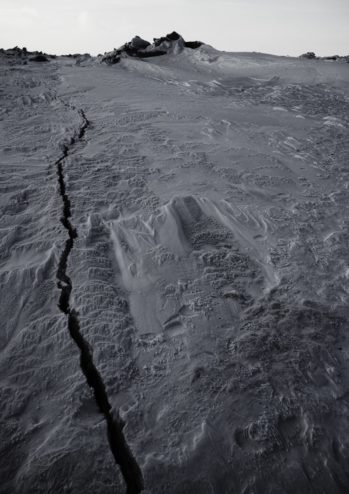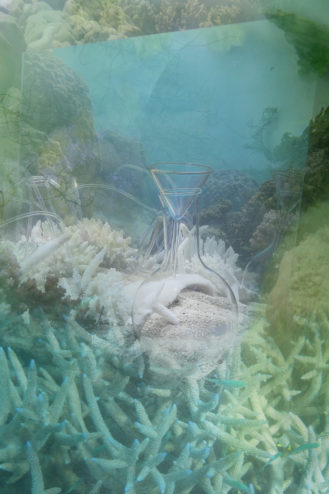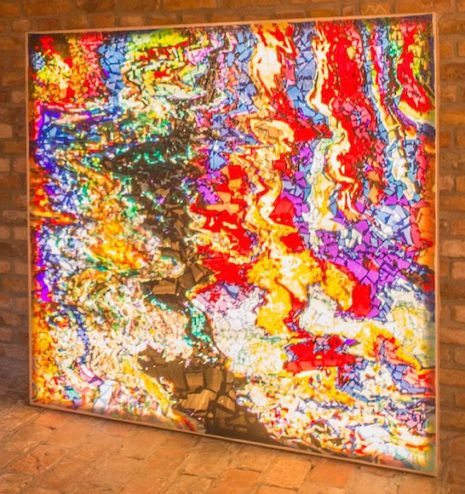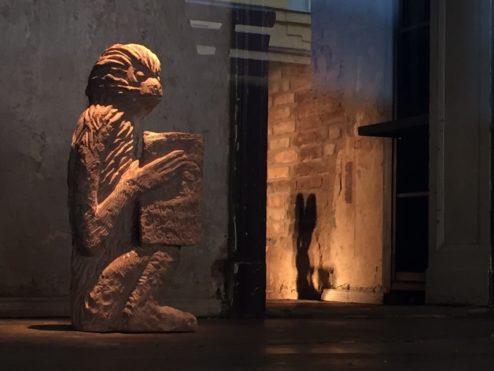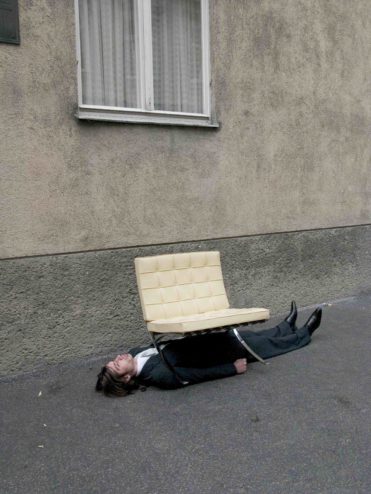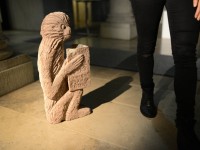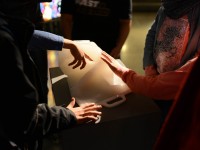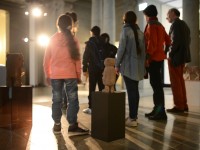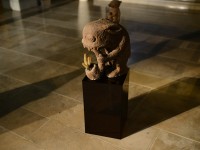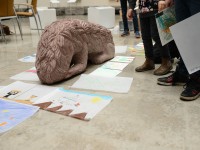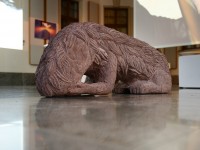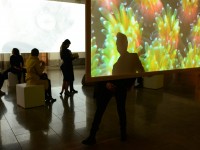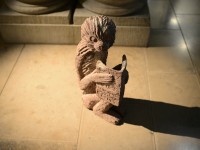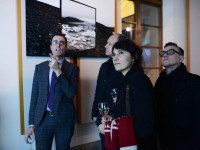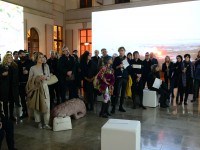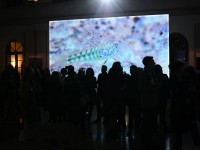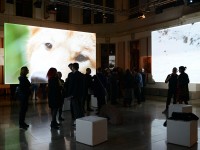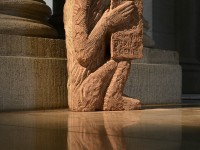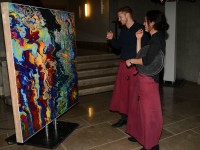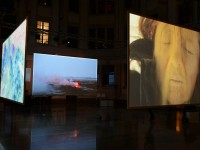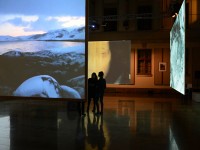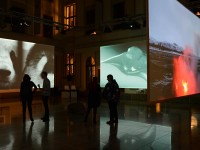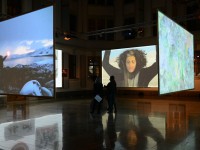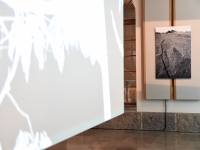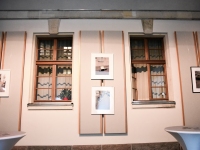Landscapes of Loss
The Exhibition for the UN Climate Change Conference, COP23
3 – 5 November in Berlin // 6 – 17 November in Bonn
An Initiative of the Ministry of Environment, Berlin > >
Landscapes of Loss
The Exhibition for the UN Climate Change Conference, COP23
Featuring:
Andreas Blank, Stefano Cagol, Nezaket Ekici & Shahar Marcus, Miru Kim,
Janet Laurence, Reifenberg, Stefan Rinck, Erwin Wurm, Shingo Yoshida
Curated by Constanze Kleiner & Rachel Rits-Volloch
3 – 5 November 2017
Stresemannstraße 128 – 130, 10117 Berlin
6 – 17 November 2017
The video works from this exhibition will also be shown at COP23
for the duration of the UN Climate Change Conference:
@ UNFCCC Secretariat, Bonn
Platz der Vereinten Nationen 1
 |
The United Nations Framework Convention on Climate Change (UNFCC), adopted 25 years ago, this year holds the 23rd World Climate Conference in Germany under the presidency of the Fiji Islands. Diplomats, politicians and representatives of civil society from all over the world meet in Bonn on 6-17 November 2017 to reach the target set by the Paris Climate Change Agreement at COP21 in 2015: to limit global warming to below two degrees Celsius and to stabilize greenhouse gas concentrations in the atmosphere at a level that will prevent dangerous human interference with the climate system. The World Climate Conference in Bonn will be the largest intergovernmental conference ever held in Germany. Up to 25,000 participants from 197 nations around the world, as well as around 500 non-governmental organizations and more than 1,000 journalists are expected. In this context, we are proud to present Landscapes of Loss in Berlin and Bonn for the 23rd World Climate Conference.
Landscapes of Loss at Berlin’s Ministry of Environment, is the exhibition for the UN Climate Change Conference, COP23, bringing together ten international artists with strong links to Berlin, who, each in their own way, address mankind’s role in relation to the environment. Through video, photography, and sculpture, this exhibition is designed as an antidote to the hyper-immediacy of the lives we live. Landscapes of Loss invites us to disengage from our phones, to stop tweeting and messaging, to switch off the data stream, to opt out of the constant barrage of the now and immerse ourselves in our planet – from the Arctic tundra of Siberia, to the deserts of the Middle East, and the jungles and seas of the Antipodes – while we still can. As the world’s climate change experts convene in Bonn in mid-November for COP23, Landscapes of Loss creates a space of contemplation and time for reflection upon the role we all play in halting the disastrous deterioration of our planet’s climate. It is not only at the governmental level that drastic changes must be made to mitigate the human impact on the environment. The damage already done will be healed through a transformation of the attitudes, expectations, and actions of every one of us. Yet this is a race against time; decisions implemented now will take years to show results. In this age of instant gratification, we need to re-learn how to think in the long-term. Landscapes of Loss asks us to stop and take the time to experience our planet at its most fragile; abandon the urgency of the now to reconnect with the rhythms and needs of the natural world.
From endangered species to the deterioration of the Great Barrier Reef, Australian artist Janet Laurence confronts us with the beauty and loneliness of creatures that could soon be the last of their kind. With the works of German sculptors Andreas Blank and Stefan Rinck, we turn from the ephemeral landscape and its vanishing creatures to the solid permanence of stone. Whether ironically recreating the detritus of our planet or populating it with totems of an alternative mythology, both artists work consciously with stone as a material reflecting the very substance of time; in its strata are recorded the ages of the planet. Berlin-based Israeli artist Reifenberg also addresses the detritus polluting our environment, working throughout his practice with plastic bags recycled into the medium of his art. Italian artist Stefano Cagol and Japanese artist Shingo Yoshida each ventured on long journeys into the Arctic to record mankind’s impact upon nature at its most extreme, and at its most threatened from the impacts of climate change; from Cagol’s solitary sojourn in the Norwegian Arctic Circle, to Yoshida’s documentation of communities surviving outside of time, straddling the International Date Line in the Siberian Arctic Circle. Out of the frozen north we visit the burning sands of Israel’s Negev Desert with Turkish/German artist Nezaket Ekici and Israeli artist Shahar Marcus. In this actual and political hotbed, time is running out, and Muslim and Jew alike are turned into human sand-clocks measuring how quickly we are getting nowhere with solutions for political and environmental stability. Likewise, Korean/American artist Miru Kim engages with the desert in Jordan’s Wadi Rum. In positioning the fragility of her own body within the drama of this natural landscape, she succeeds in highlighting the fragility of the landscape itself. Austrian artist Erwin Wurm brings us out of the jungles and seas, the Arctic wastes, and the scorching deserts, back into the city. Our urban landscape is an environment changing as rapidly as our natural one. In confronting through absurdity our place in the urban landscape, the humor inherent to these scenarios gives us hope that humanity will find a way to fit into all the world’s landscapes, however fragile the balance.
ARTISTS AND WORKS
This exhibition ranges from the ephemeral landscape and its vanishing creatures, to the solid permanence of stone. German artist Andreas Blank is a sculptor working exclusively with stone. He is conscious of his chosen medium as a material reflecting the very substance of time; in its strata are recorded the ages of the planet. In Untitled (2010) Andreas Blank fashions out of quartz a perfect replica of a plastic bag, turning his art to sculpting the detritus of our planet, recreating in timeless stone the all too temporary objects of the day-to-day. Untitled (2010) is on loan for this exhibition from the Collection of the Ministry of the Environment.
Landscape Metaphor (2014), sculpture, quartz
Andreas Blank was born in Ansbach in 1976. He attended the Karlsruhe State Academy of Art (Staatliche Akademie der Bildenden Künste) and was Meisterschüler under Prof. Klingelhöller. He held a scholarship with the German National Academic Foundation and received his MFA from the Royal College of Art in London. In 2009 he was a finalist for the New Sensations Award by Channel 4 and the Saatchi Gallery. He lives and works in Berlin. Andreas Blank‘s stone encarved trompe l’oeils seem casual at first sight. However, his arrangements are precisely staged and after closer inspection one discovers that light bulbs, transport boxes and plastic bags are made of marble, alabaster or sandstone. In his sculptural practice, Andreas Blank combines the abstract and the realistic, the conceptual as well as the technical. He sources stones from quarries from all over the world, carves them with elaborate deliberation and assembles them into sometimes consciously stylized, and other times deceptively realistic objects of the everyday. In his precise installations, the apparently ephemeral objects achieve monumental permanence. Whether marble, alabaster, or porphyry, material historically used to serve religious or political functions, has in Blank’s hands acquired the seemingly casual character of the mundane and wasteful. Questioning the obvious and transforms traditional ideals and values, the geographical and cultural identity of the stone and the memorial function of stone-sculpture in general subvert our usually impermanent relation to the objects we use.
The impact which mankind has upon the natural environment is at the root of this work created at Kirkenes, in the Norwegian Arctic Circle, during one of the periods Cagol spent abroad as an artist in residence. The artist staged a series of emblematic actions that he filmed with a video camera, in total solitude, immersed in a fascinating but hostile natural environment, in extreme climactic conditions. The setting seems to be cloaked in twilight, barely dispelling the darkness, and the temperature is 25 degrees below zero. In those frozen lands, Cagol tries to communicate in one way or another, using different forms of signaling. He endeavours to modify the landscape, to light it up, to melt the snow with a flame, but every attempt at interaction with this harsh environment is in vain. The irony here is not lost. While one man cannot make a visible impact upon this frozen landscape, the impact of mankind as a whole is all too devastating. For Cagol in this case the border is precisely the one between himself, his body and his mind, the extreme nature that surrounds him, and the impact which mankind has upon this natural environment. Evoke Provoke (The Border) was shown at the solo exhibition Concilio in the church of San Gallo, as a collateral event at the 54th Venice Biennale.
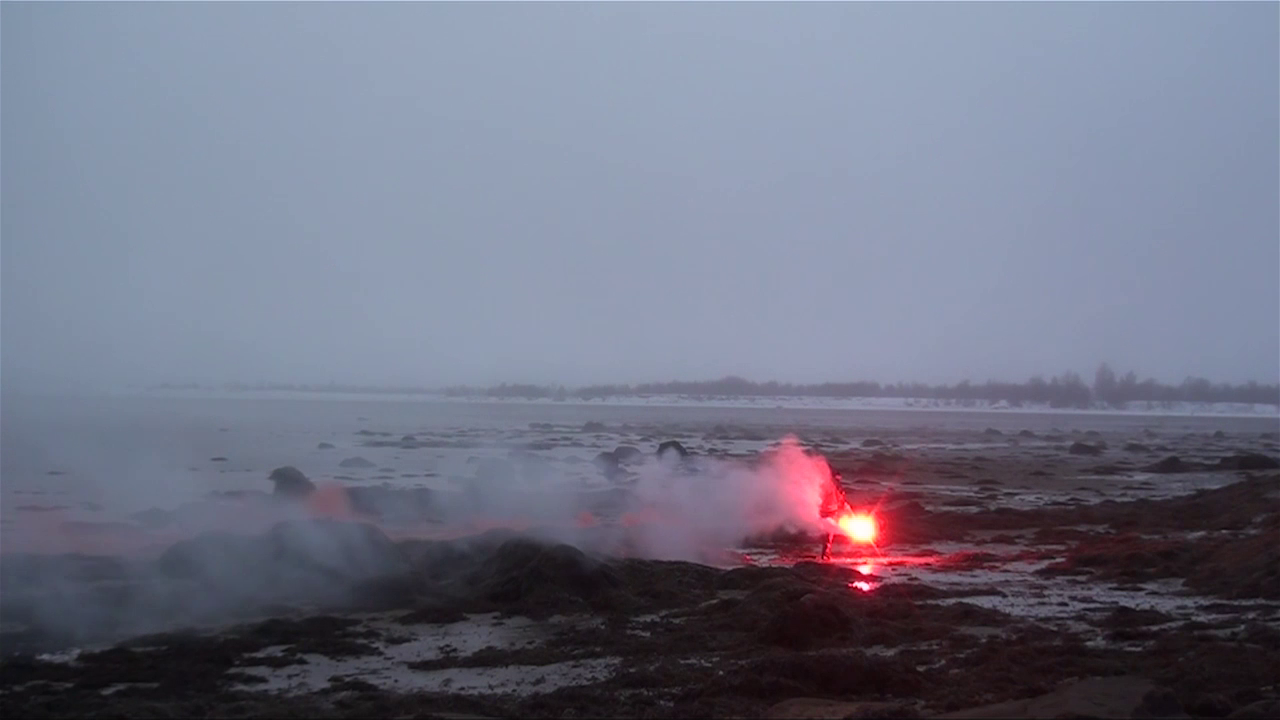
Evoke Provoke [the border] (2011), HD video 12’30”
Stefano Cagol (Trento, 1969) received a post-doctoral fellowship at the Ryerson University in Toronto, Canada, after having graduated from the Accademia di Brera in Milan. He participated in Manifesta 11 and Manifesta 7; at the 55th Venice Biennale, invited by the Maldives Pavilion; at the 54th Venice Biennale with a solo collateral event; and at the 1st Singapore Biennale. In 2017 a still from Evoke Provoke [the border] becomes part of the Collection of the German Ministry of Environment (Sammlung Bundesministerium für Umwelt, Deutschland), and he is part of the grand inaugural exhibition curated by Veit Loers at Haus Mödrath – Räume für Kunst in Cologne. In 2014-2015 his solo project “The Body of Energy (of the mind)” was presented at a series of European museums, such as the MAXXI Museum in Rome, Madre Museum in Naples, Maga Museum in Gallarate, Museion in Bolzano, Kunsthalle St. Gallen, ZKM in Karlsruhe, Museum Folkwang in Essen, Landmark / Bergen Kunsthall. Among grants and awards he won the Visit prize of Innogy Foundation in 2014 (Germany) and the Terna Prize for Contemporary Art in 2009 (Italy). He has been selected for many artist in residence programs including: Ruhr Residence 2016; Cambridge Sustainability Residency 2016; Air Bergen; BAR International in Kirkenes; International Studio and Curatorial Program ISCP in New York; ICP-International Center of Photography in New York.
Turkish/German artist Nezaket Ekici and Israeli artist Shahar Marcus together address geopolitical and environmental forces through the medium of performance in their video Sandclock (2012). Shot in the burning sands of Israel’s Negev Desert, their performance ironically confronts human endurance with the extremes of nature and culture. In this actual and political hotbed, time is running out, and Muslim and Jew alike are turned into human sand-clocks measuring how quickly we are getting nowhere with solutions for political and environmental stability.
Nezaket Ekici and Shahar Marcus both work separately as artists but started to collaborate on projects in 2012. Their ongoing project In Relation revolves around an exploration of time, space, culture, religion, and the often absurd ways in which people interact with the environment. In this, as a German-based Muslim and an Israeli-based Jew, they collaborate on performances and videos that bridge cultures and religions as well as the long distances between Berlin and Tel Aviv. Focusing on the origin of the latin word relatio (relation), meaning ‘bringing back’, they set out to bring back a knowledge that has been forgotten by most of us: a relation with ourselves and our environment. Since 2012 they have produced seven video works together: Salt Dinner, Sand Clock, Floating Ourselves, Clean Coal, Fossils, Fields of Breath and Lublin Beach, all concentrating on the Ancient Greek aphorism γνῶθι σεαυτὸν: know thyself.
Sandclock (2012), HD video 5’7″
Nezaket Ekici was born in 1970 in Kırşehir, Turkey, and lives and works between Berlin and Stuttgart. She studied art pedagogy, art history, and sculpture at Ludwig Maximilian University and the Fine Arts Academy, Munich, and received her MA degree in art pedagogy (1994–2000). Thereafter, she studied performance art with Marina Abramovic at the Hochschule der Bildenden Künste Braunschweig, where she received her BFA and MFA (2001–04). Nezaket Ekici recently participated in the prestigious international Artist Resedency Programs of the German Aacademy in Rome at the Villa Massimo (2016-2017), and the German Foreign Ministry Residency in Tarabia, Istanbul (2015-2016). Recent group exhibitions include: 56th Venice Biennale, 2015; Petach Tikva Museum of Art, Israel, 2015; The Pleasure of Love, 56th October Salon, Belgrade, 2016; The Contemporary Art Gallery of Georgia, Georgia National Museum, Tbilisi, 2016; MOCAK, Museum of Contemporary Art, Krakau, 2016; Museum Villa Rot, Burgrieden, 2016; Gabriele Münter Preis, Akademie der Künste, Berlin & Frauenmuseum, Bonn, 2017.
Shahar Marcus was born 1971 in Petach Tikva, Israel, and lives and works in Tel Aviv. He studied Linguistics at the University of Tel Aviv (1993–1997), and continued his studies for an M.A. in History of Art (1999–2004) at the University of Tel Aviv. Selected solo exhibitions include: Going, Going Gone, Haifa Museum of Art, Haifa (2015); All is Gold, The Municipal Gallery, Rehovot (2014); Solo project at Threshold Gallery, India Art Fair, New Delhi (2013); 1,2,3 Herring, MoCA Hiroshima, Hiroshima (2012); The Curator, The Petach Tikva Museum of Art; The Memorial Employee, Dana Art Gallery, Kibbutz Yad Mordechai (2011); Bread & Bunker, Mediations Biennale, Poznań (2010).
Korean/American artist Miru Kim, in her Camel’s Way series (2012), immerses herself in the world’s deserts for over two years. The Camel’s Way follows her journey to deserts around the world, including the Arabian Desert, the Sahara in Mali, Morocco, and Egypt, the Thar in India, and the Gobi Desert in Mongolia, where she lived with desert nomads, slept in caves, and photographed herself with camels. In the work shown in this exhibition, the female nude, an archetype since the dawn of western art history, is transposed to the sands and mountains in a 3-week journey through Jordan’s Wadi Rum Desert. In positioning the fragility of her own body within the drama of this natural landscape, Miru Kim succeeds in highlighting the fragility of the landscape itself.
Wadi Rum, Jordan, Arabian Desert 3 from the The Camel’s Way series (2012), photograph
Miru Kim was born in Stoneham, Massachusetts in 1981, but was raised in Seoul, Korea. She moved to New York in 1999 to attend Columbia University, and in 2006 she received an MFA in painting from the Pratt Institute. Miru Kim is a New York-based artist and explorer. Her first series, Naked City Spleen is based on her exploration of urban ruins such as abandoned subway stations, tunnels, sewers, catacombs, factories, hospitals, and shipyards. Her next series, The Pig That Therefore I am juxtaposes her skin against the pig’s skin in industrial hog farms to explore the changing relationship between humans and animals. Currently she is working on a book about her body of work, The Camel’s Way.Miru’s work has been featured in many international publications, and is held in public collections including: the National Museum of Modern and Contemporary Art, Korea; Seoul Museum of Art; Hanmi Photography Museum; Leeum Samsung Museum of Art; Borusan Contemporary, Turkey; and the Addison Gallery of American Art.
SHINGO YOSHIDA
Japanese artist Shingo Yoshida ventured on a long journey into the Arctic to record mankind’s impact upon nature at its most extreme. Yoshida’s journey in his film The End of Day and Beginning of the World (2015) took him to Siberia, to the point where the Arctic Circle crosses the 180th Meridian, the basis for the International Date Line separating two consecutive calendar days. Inspired by local Chukchi folklore and customs, this film is a journey into a place where nature rules, and mankind clings to the traditions of their ancestors in order to survive. Straddling the border between two days, it is a place of strong mythologies and magical landscapes; an environment of extremes which defies man-made borders and mankind’s influence, yet is still perilously close to destruction from climate change.
The End of Day Beginning of the World (2015), 4K Video 22’8″
Photographer and video artist, Shingo Yoshida, finds inspiration in travelling, myths, traditions and the overwhelming beauty of nature. Yoshida considers the world as his studio and therefore a place of constant creation. In his video and photographic works Yoshida expresses his deep reverence for nature and its power. In his photo series Journey to the Center of the Earth, Yoshida travels to Iceland to envision his own reinterpretation of Jules Verne’s eponymous book.
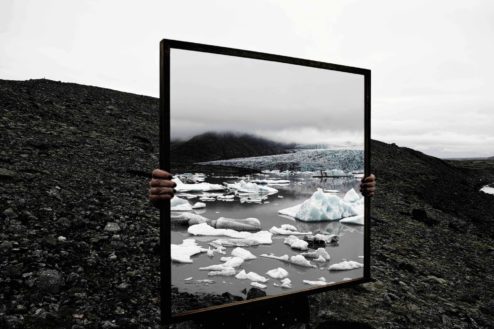
Journey to the Center of the Earth (2014), photograph
Shingo Yoshida, born in 1974 in Tokyo, and currently lives and works in Berlin. Yoshida received his MA with highest honors from Ecole Nationale Supérieure d’Art, Villa Arson in Nice France in 2004. In 2005 he earned a post-graduate diploma at the Ecole Nationale Supérieure des Beaux-Arts de Lyon, France, and subsequently in 2007 he received another post-graduate diploma in the Program La Seine of Ecole Nationale Supérieure des Beaux- Arts de Paris. in 2013 Yoshida completed the prestigious international artist residencies at Villa Arson Nice France – Centre National d’Art Contemporain, and was awarded the Fellowship of Overseas Study Programme for Artists by the Agency for Cultural Affairs of the Japanese Government. Yoshida’s work has been shown in many international exhibitions, including: Palais de Tokyo, Paris (2007, 2012); the Museo de Arte Contemporáneo MAC, Santiago, Chile (2012); the 60th International Short Film Festival Oberhausen, Germany, (2014); Videoart at Midnight #67: Shingo Yoshida, BABYLON, Berlin (2015); POLARIZED! Vision Competition Winner, Lapland, Rovaniemi, Finland (2015); Gunma Museum of Art, Tatebayashi, Gunma, Japan (2016); Mulliqi Prize, National Gallery of Arts, Prishtina, Kosovo (2016); Instituto Zappa (Accademia Di Brera) Viale Marche, Milan, Italy (2016); Onufri International Prize, National Gallery of Arts, Tirana (2016); IkonoTV (2017). In 2016 Shingo Yoshida’s works entered into the following Collections in Berlin: Berlinische Galerie, Akademie der Künste, and Fluentum.
Of the ten artists in this exhibition, renowned Australian artist Janet Laurence is most known for her work with the environment, often undertaken together with scientists engaged in international conservation initiatives. Laurence’s practice is a direct response to contemporary ecological catastrophes, positioning art within the essential dialogue of environmental politics to create and communicate an understanding of the impact that humans have upon the threatened natural world, in order to restore our vital relationships with it. Works from two series are shown here: the Vanishing series, depicting endangered animals on the verge of extinction; and Deep Breathing, shot while working with scientists researching corral collapse in Australia’s Great Barrier Reef, and commissioned for Artists 4 Paris Climate, the exhibition program for COP21, the UN Climate Change Conference in 2015.
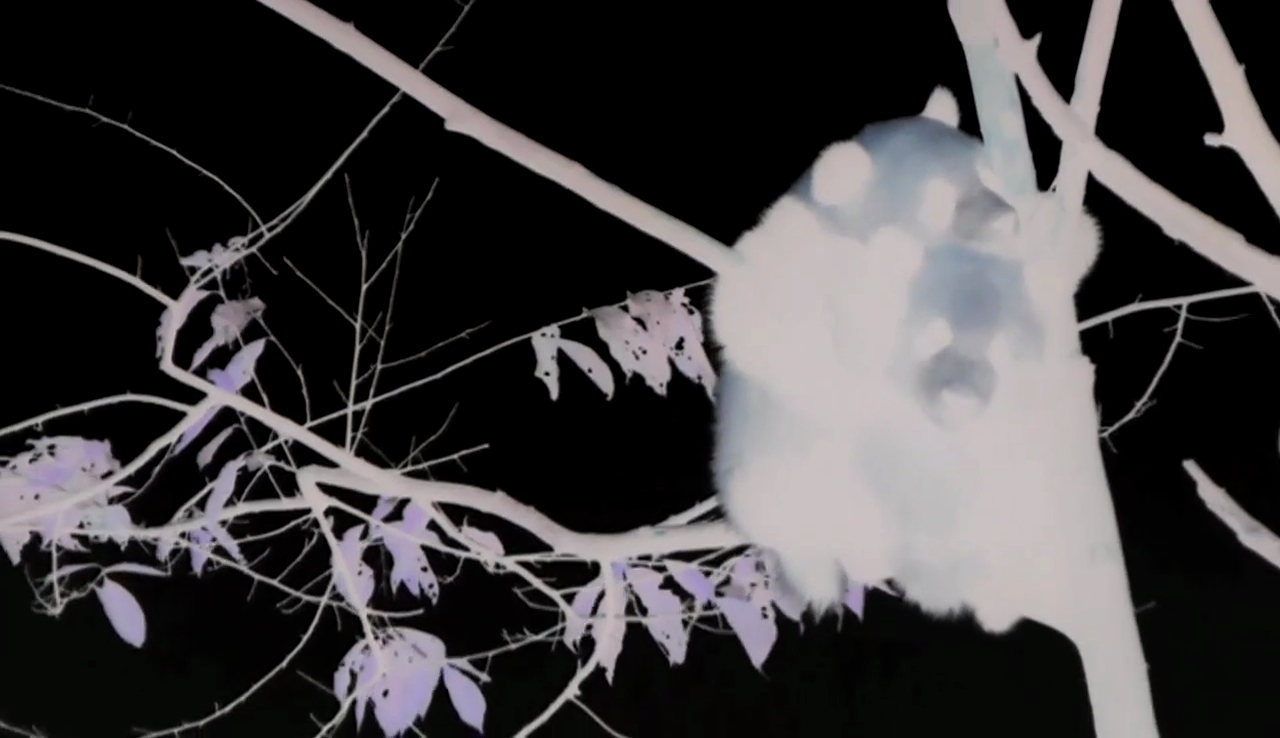
The Other Side Of Nature / Panda (2014), HD video 9’18”
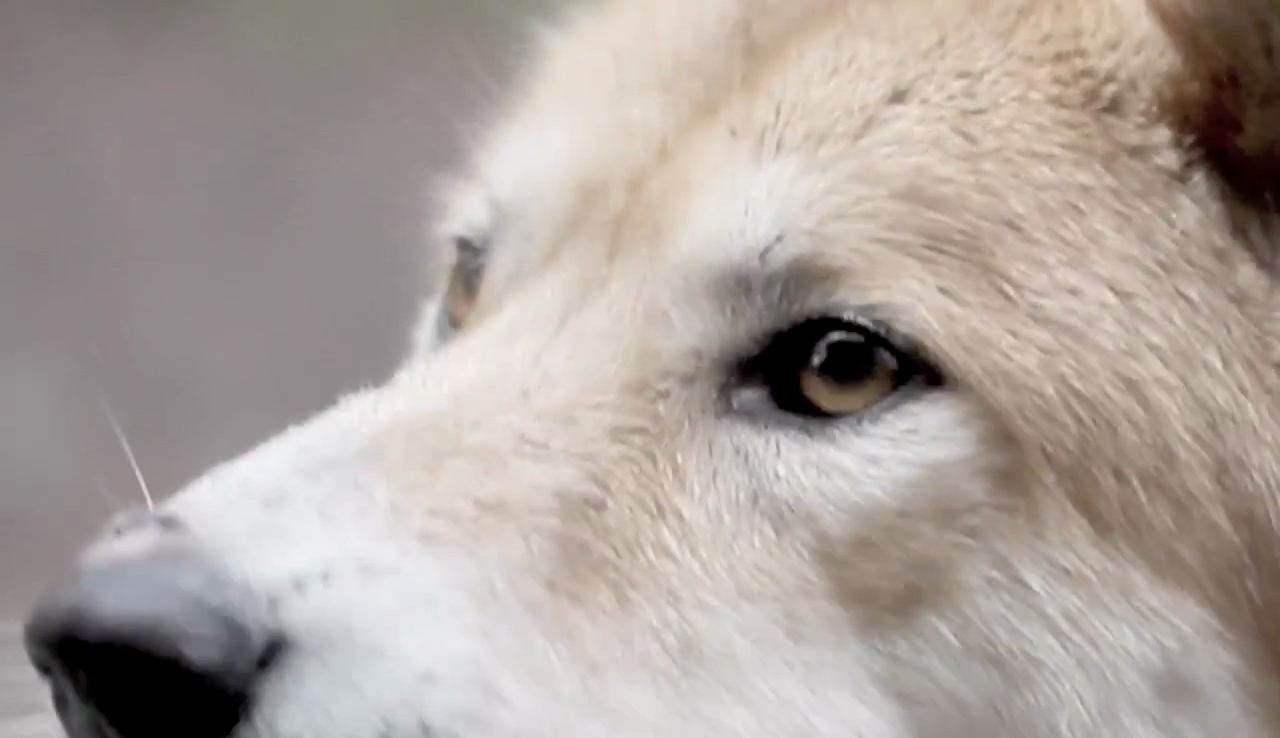
Dingo (2013), HD video 4’9″
Reflecting on the loneliness of the last of a species, The Other Side of Nature / Panda (2014), and Dingo (2013), shot in nature reserves in Chengdu, China and Victoria, Australia, chronicle in intimate proximity the lives of animals that could soon be the last of their kind.
“These are the days of violent extinctions, of global dimming and moving dust bowls, of habitat fragmentation, ice melt, and plundered lives. Animals are experiencing all this loss, and if we could better hear the waves of their agony, we would know this and be tormented.” (Debbie Bird Rose)
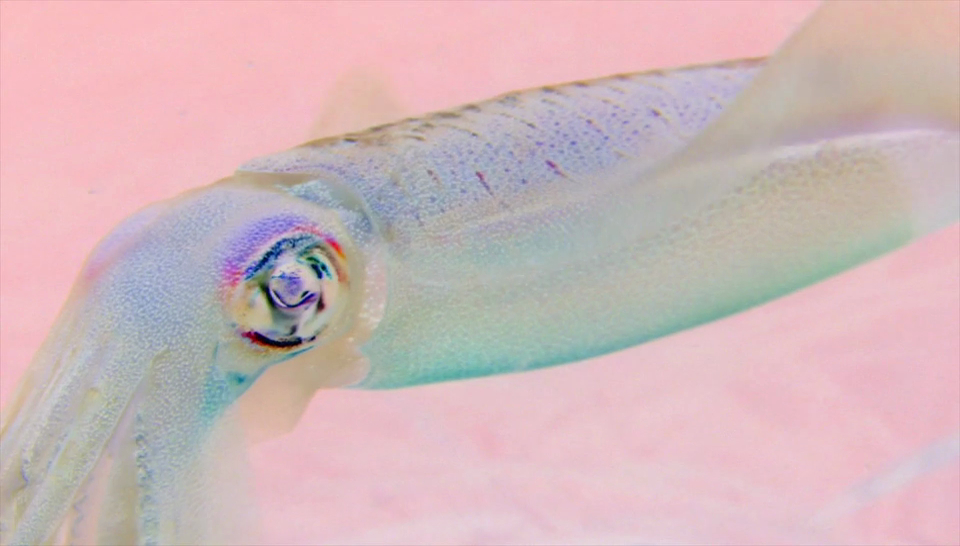
Deep Breathing: Resuscitation for the Reef (2015), HD video 32’58”
Janet Laurence’s video Deep Breathing – Resuscitation for the Reef (2015), and accompanying photo series Corral Collapse Homeopathy (2015) were created for the UN Climate Conference,COP21, in Paris. Shot in Australia’s Great Barrier Reef – a World Heritage site which is the planet’s largest living, and rapidly dying, structure – this series of works envisions a hospital for the Reef’s threatened corals and other marine species, making visible the otherwise invisible devastation beneath the surface of the sea, and offering hope for the healing of the marine world from the consequences of global warming and human impact. If we can care for marine life in the same way that we care for our own species, there is a chance of deflecting environmental catastrophe. Laurence’s work is an emergency response: a hospital for the Reef in this time of ecological crisis, intended to aid survival and effect transformation.
Corral Collapse Homeopathy No. 8 (2015), series of 10 photo
Janet Laurence is among Australia’s most established artists. In 2015 she was the Australian representative for the COP21/FIAC, Artists 4 Paris Climate Exhibition for the UN Climate Conference in Paris, for which she created Deep Breathing – Resuscitation for the Reef and Corral Collapse Homeopathy, both shown in this exhibition. Further selected recent international projects and exhibitions include: the 57th Biennale of Venice (2017); Veiling Medical Glass, A Medicinal Maze, Novartis Campus, Sydney (2017); The Treelines Track, Bundanon, Australia (2017); GASP: Parliament, Hobart, Tasmania (2017); Inside the Flower, IGA Berlin (2017); Schloss Biesdorf, Centre for Art and Public Space, Berlin (2017); Fellowship at the Hanse-WissenschaftKolleg (HWK), Germany (2016-2017); H2O Water Bar, Paddington Water Reservoir, Sydney (2016); Deep Breathing (Resuscitation for the Reef), Australian Museum, Sydney (2016); Cuenco Bienal, Cuenco, Ecuador (2016); Deep Breathing: Resuscitation for the Reef, Musée National d’Histoire Naturelle, Paris (2015); The Skullbone Experiment: A Paradigm of Art and Nature, Queen Victoria Museum, Tasmania (2014); Animate/ Inanimate, TarraWarra Museum of Art, Healsville, Victoria, Australia (2013); 1⁄2 Scene, Australia China Art Foundation Shanghai (2013); SCANZ: 3rd Nature, New Plymouth, New Zealand (2013); After Eden, Sherman Contemporary Art Foundation, Sydney (2012); The Alchemical Garden of Desire, McClelland Gallery, Victoria, Australia (2012). Janet Laurence is a recipient of Rockefeller, Churchill, and Australia Council Fellowships, and the Alumni Award for Arts, University of New South Wales. She was a Trustee of the Art Gallery of New South Wales, a former Board Member of the Visual Arts Board of the Australia Council, and is a Visiting Fellow at the New South Wales University Art and Design.
Berlin-based Israeli artist Reifenberg addresses the detritus polluting our environment, working throughout his practice with plastic bags recycled into the medium of his art. In Oil Spill 12.10 (2010) he fashions a lightbox recreating the satellite image of an oil spill; ironically using the petroleum-based material of the ubiquitous plastic bag to depict one of the many man-made catastrophes to devastate our planet. In using the trash of consumerist excess and a pollutant of our environment as the material of his artworks, Reifenberg’s works live from the inner tension between commodity fetishism and worthlessness, the world of consumerism and decay, colourful splendor and environmental destruction. And in making Oil Spill 12.10 into a lightbox, Reifenberg adds the tension between the sacred and profane; creating out of trash the likeness of a stained glass window, only to depict demise of our environment in its mosaic of colours.
Oil Spill (2010/2017), lightbox
Reifenberg was born in Haifa, Israel, in 1960 and studied Philosophy of Aesthetics at Gideon Ofrat in Tel Aviv. Reifenberg left his homeland during the Lebanon War in 1982, and since 1988 he has lived and worked in Berlin. He has participated in numerous international exhibitions, including: Museo Metropolitano, Lima, Peru (2015); Stiftung Zollverein, Essen (2014); dotLand, Peninsula, Berlin (2014); Musraramix Festival, Jerusalem (2014); Natura Naturata, WiE Gallery, Berlin (2014); Conjunction, Greenhous, Berlin (2014); Capilla del Arte UDLAP, Mexico (2014); Marta Traba, Sao Paulo (2013); Pool, MUDAC, Lausanne (2013); Memory of Present, coup de des, Berlin (2012); Green Bag – Movement, Nachahmung Empfohlen!, Iberia Center, Peking (2012)
German artist Stefan Rinck is a sculptor working exclusively with the solid permanence of stone. Conscious of the timelessness of his medium, Stefan Rinck creates creatures reminiscent of a bygone age of totems and effigies. In the series of five sculptures shown in this exhibition – Die Streichwürstin (2017), Chiaroscuro (2014), Gibbons don’t have good press (2014), Roo (2013), and Unicorn (2009) – Stefan Rinck builds an alternative mythology, pitting man-made time against the timelessness of imagination, populating our world with eternal creatures of stone able to withstand any extinction.
Gibbons Don’t Have Good Press (2014), sculpture, sandstone
Stefan Rinck was born in 1973 in Homburg/Saar, and currently lives and works in Berlin. Rinck studied Art History and Philosophy at the Universität des Saarlandes in Saarbrücken, and Sculpture at the Academy of Arts in Karlsruhe. Stefan Rinck has had many gallery and museum exhibitions, including: Sorry We`re Closed (Brussels), Vilma Gold (London) and Patricia Low Contemporary (Gstaad, St. Moritz), de Hallen (Haarlem), Gallery Rüdiger Schöttle (Munich), The Breeder (Athens), Galeria Alegria (Madrid), Cruise&Callas and Klara Wallner Gallery (both in Berlin). He participated in the Busan Biennale in South Korea and at the Vent des Foret in France where he has realized permanent public sculptures.
In this exhibition, celebrated Austrian artist Erwin Wurm brings us out of the jungles and seas, the Arctic wastes, and the scorching deserts, back into the city. Our urban landscape is an environment changing as rapidly as our natural one. The way people have lived upon this planet for millennia in family groups and villages is well on its way to being replaced by the megacity, with millions living and working packed into faceless high-rises. Erwin Wurm’s photo series of one-minute sculptures, Leopoldstadt (2004), confronts through absurdity our place in the urban landscape. The solitary figures posing incongruously in empty streets could be seen as a sign of urban alienation, but the humor inherent to these scenarios gives us hope that humanity will find a way to fit into our landscape, however fragile the balance.
Erwin Wurm came to prominence with his One Minute Sculptures, a project that he began in the late 1980s. In these works, Wurm gives written or drawn instructions to participants that indicate actions or poses to perform with everyday mundane objects. These sculptures are by nature ephemeral, and by incorporating photography and performance into the process, Wurm challenges the formal qualities of the medium as well as the boundaries between performance and daily life, spectator and participant. While in this series he explores the idea of the human body as sculpture, Wurm consistently works within the liminal space between high and low, merging genres to explore what he views as a farcical and invented reality. While Wurm considers humor an important tool in his work, there is always an underlying social critique of contemporary culture.
Leopoldstadt, 07 (2004), one-minute performance photograph
Erwin Wurm was born in 1954 in Bruck an der Mur/Styria, Austria, and lives and works in Vienna and Limberg, Austria. He graduated from the University of Graz, Austria, in 1977, and Gestaltungslehre University of Applied Art and the Academy of Fine Art, Vienna in 1982. Recent solo exhibitions include: The Austrian Pavilion, the 54th Biennale of Venice (2017); 21er Haus, Belvedere, Vienna (2017); Museum Küppersmühle für Moderne Kunst, Duisburg, Germany (2017); Leopold Museum, Vienna (2017); Centro Cultural Banco do Brasil, São Paulo, Brazil (2017); Berlinische Galerie, Berlin (2016); Schindler House, MAK Center for Art and Architecture, West Hollywood, CA (2016); Bangkok Art and Culture Center, Thailand (2016); Indianapolis Museum of Art, IL (2015); Museum of Contemporary Art in Kraków, Poland (2013); Centro de Arte Contemporáneo de Málaga, Spain (2012); and Dallas Contemporary, TX (2012). Select group exhibitions include: Performing for the Camera, Tate Modern, London (2016); Precarious Balance, Centre of Contemporary Art, Christchurch, New Zealand (2016); Desire for Freedom, Museum of Contemporary Art in Kraków, Poland (2013); HEIMsuchung: Uncanny Spaces in Contemporary Art, Kunstmuseum Bonn, Germany (2013); The Original Copy: Photography of Sculpture, 1839 to Today, Kunsthaus Zürich, Switzerland, traveled to The Museum of Modern Art, New York (2011); and Temporary Structures: Performing Architecture in Contemporary Art, deCordova Sculpture Park and Museum, Lincoln, MA, USA (2011). Wurm’s work is in numerous international public and private collections, including Albertina, Vienna; Albright-Knox Art Gallery, Buffalo, New York; Centro de Arte Contemporáneo de Málaga, Spain; Centre Georges Pompidou, Paris; Kunsthaus Zürich, Switzerland; Kunstmuseum Bonn, Germany; Museo d’Arte Moderna di Bologna, Italy; The Museum of Modern Art, New York; Solomon R. Guggenheim Museum, New York; Vancouver Art Gallery, Canada; and Walker Art Center, Minneapolis.
ABOUT THE CURATORS
Dr. Rachel Rits-Volloch is a graduate of Harvard University with a BA degree in Literature, and holds an M.Phil and PhD from the University of Cambridge in Film Studies. She wrote her doctoral dissertation on visceral spectatorship in contemporary cinema, focusing on the biological basis of embodiment. In 2016-2017, Rachel Rits-Volloch was Visiting Professor at the Bauhaus University, Weimar, lecturing in the MFA program “Public Art and New Artistic Strategies” and the PhD program in Artistic Research. Rachel Rits-Volloch is Director of the non-profit global platform for time-based art, MOMENTUM, which she founded in 2010.
Having been founded in Sydney, Australia, as a parallel event to the 17th Biennale of Sydney, in 2011 MOMENTUM moved to Berlin to the thriving Kunstquartier Bethanien Art Center. MOMENTUM’s mission is to continuously reassess the growing diversity and relevance of time-based practices, with an aim to support artists and artistic innovation in Berlin and worldwide. MOMENTUM’s program is composed of local and international Exhibitions, Artist and Curator Residencies, Video Art in Public Space Initiatives, Performance and Education Programs and Archives, and a growing Collection. Since MOMENTUM’s inception in May 2010, Rachel Rits-Volloch has curated or produced over 65 international exhibitions showing works by over 500 artists, in addition to ongoing education programming, artist residencies, and related projects. Rachel Rits-Volloch is currently based in Berlin, Germany.
Constanze Kleiner has more than 20 years of experience in the field of art and culture. After majoring in Slavic Studies and German Language and Literature, Kleiner began her curatorial career as founder and managing partner of the production company White Cube Berlin, which realized the exhibition project 36x27x10 in Berlin’s former Palast der Republik (2005). When this iconic landmark was torn down, Kleiner founded the Temporary Kunsthalle on the same site. Constanze Kleiner headed the Temporary Kunsthalle as managing partner and was responsible for concept and implementation from 2007 to 2009. From November 2012 until October 2013 she was the first Chief Curator of the newly founded TRAFO Center for Contemporary Art in Szczecin, Poland. In 2017 Kleiner founded her peripatetic gallery Schlachthaus Fresh&Fine Art, with an ongoing exhibition program throughout multiple venues in Berlin.
Constanze Kleiner has worked as curator and advisor on many international exhibitons, including: Gregor Schneider, STERBERAUM, National Museum in Szczecin, Poland (2012); Ryszard Wasko, Genesis, TRAFO Center for Contemporary Art in Szczecin, Poland (2012); Christian Jankowski, The Eye Of Dubai, National Museum in Szczecin, Poland (2013); THRESHOLDS, MOMENTUM Berlin, Collegium Hungaricum Berlin, and TRAFO Center for Contemporary Art in Szczecin, Poland (2013); Sanatorium Artist Residency Exchange, MOMENTUM Berlin and TRAFO Center for Contemporary Art in Szczecin, Poland (2013-2014); WE ALL LOVE ART, Schlachthaus Fresh& Fine Art, Berlin (2017); The Landscape In Us, Schlachthaus Fresh& Fine Art, Berlin (2017); Landscapes of Loss, for the UN Climate Conference COP23, Ministry of Environment, Berlin (2017).


 Back to Homepage
Back to Homepage